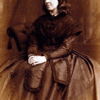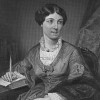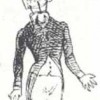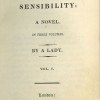
Ellen Crowell, “Oscar Wilde’s Tomb: Silence and the Aesthetics of Queer Memorial”
This entry looks at how, in the aftermath of Oscar Wilde’s death, those individuals closest to the writer sought a suitable funerary monument in memorial. I first explore the interpersonal and aesthetic politics that informed the choice of Jacob Epstein as the tomb’s commissioned sculptor, and how that choice must be understood as integral to how we remember Wilde today. Noting how profoundly the aesthetics of funerary sculpture are in dialogue with both literary and queer history, this essay also briefly imagines how an alternate monument adorning Wilde’s tomb might have differently configured that dialogue. By comparing Epstein’s tomb with the radically different aesthetics that guide a “rejected” design, this one by the writer’s close artistic collaborator and friend Charles Ricketts, this essay considers how aesthetics have shaped twentieth and twenty-first century approaches to queer memory, mourning, and modernity.

Rachel Teukolsky, “Walter Pater’s Renaissance (1873) and the British Aesthetic Movement”
Walter Pater’s Studies in the History of the Renaissance is known as the “golden book” of the British Aesthetic movement. Though ostensibly focused on Italian Renaissance art, the book speaks obliquely to Pater’s own Victorian moment, challenging conventional codes of religion, morality, sexuality, and scholarship. This essay surveys Pater’s diverse methods of quiet rebellion, including his ironic treatment of critical and scholarly norms. The essay’s second part considers the relation of The Renaissance to the emergence of popular aestheticism in the later 1870s.

Janice Schroeder, “On the English Woman’s Journal, 1858-64″
The English Woman’s Journal (EWJ), published between 1858 and 1864, was the first monthly magazine to be published by an organized feminist network in England. From month to month, the EWJ featured a mix of articles on women’s employment, education, and volunteering, notable women in history, poetry, reviews, current events, and a readers’ column. Staffed by women with primarily female contributors, the magazine embodied the principles and opportunities for women it promoted. That is, in a rapidly changing industrial landscape, women needed new and better avenues of remunerative, meaningful employment, and the education and training required to succeed in the workforce. Marriage and motherhood—the domestic ideal—was not a guarantee of women’s economic or emotional well-being. Working with a meager budget, the circle of feminist activists—the Langham Place Group—who owned and ran the EWJ, saw their magazine as a space to promote and publicize the work they and other women were already doing. They experienced both the thrill and the shock of seeing their magazine, and themselves, noticed in the mainstream, male-dominated press. By 1862 the magazine had run into serious financial straits and many of the members of the network had either moved on to new projects or retired from public work. While maintaining a small subscription base throughout its six-year run, the appearance of the English Woman’s Journal in mid nineteenth-century England nevertheless signaled a new departure in feminist writing, women’s journalism, and attitudes towards women’s employment.

Kelly Hager, “Chipping Away at Coverture: The Matrimonial Causes Act of 1857”
The Matrimonial Causes Act of 1857 made divorce legal under British law and was the first law to protect a wife’s property. It was thus the second piece of legislation (after the 1839 Custody of Infants Act) to require Parliament to examine the ramifications of the common law doctrine of coverture; the passage of these two acts began to chip away at that cruel precedent. While the bill originally introduced in 1854 was procedural in nature—designed to remedy the anomaly of a legal system that granted divorces by Private Act of Parliament though divorce was, strictly speaking, illegal—by the time it became law, three years later, the public debate over the rights of married women had become so heated that the final version of the bill not only put divorce on the books and made it straightforwardly and absolutely legal, but also provided for the protection of divorced, separated, and deserted wives.

Lana L. Dalley, “On Martineau’s Illustrations of Political Economy, 1832-34″
Harriet Martineau’s conception of fictional and economic discourses as compatible, her confidence that a woman could effectively and authoritatively write about political economy, and Illustrations’ resonance throughout the period mark Illustrations of Political Economy‘s conception, publication, and reception as important events in the history of nineteenth-century literature and culture.

Peter Capuano, “On Sir Charles Bell’s The Hand, 1833″
This essay explores the cultural context in which Sir Charles Bell’s 1833 Bridgewater Treatise was published by focusing on the work as a culmination of his deep religious faith, his Edinburgh anatomical training, and his occupation as a surgeon at the Leeds Infirmary. It argues that The Hand was not merely an extension of Paleyan natural theology but also an important response to the era’s struggle with the grim physical reality of the supersession of manual labor by automatic manufacture.

Jo Briggs, “1848 and 1851: A Reconsideration of the Historical Narrative”
The revolutionary year of 1848 has been seen as producing little effect on art in Britain. However, the turn to visual culture, which considers a broad spectrum of material including prints, illustrated periodicals, advertisements and other popular and ephemeral forms of visual production, allows this assumption to be rethought. By decentralizing the notion of an originary moment of formal innovation among a select group of avant-garde painters, as has been emphasized with regard to Paris, and turning to British visual culture, the effects of revolution become diffuse and plural. As a result, chronologies need to be rethought, and the revolutions of 1848 and the Great Exhibition of the Work of Industry of All Nations of 1851 reconnected.

Ayla Lepine, “On the Founding of Watts & Co., 1874”
In 1874 three prominent Victorian architects founded the ecclesiastical and domestic fittings and furnishings business Watts & Company: George Gilbert Scott junior, Thomas Garner, and George Frederick Bodley. The firm was established within a cultural climate of transition. By the 1870s, the Gothic Revival and the Aesthetic Movement began to overlap and merge. Sacred and secular architectural and decorative impulses increasingly shared common traits. These aesthetic shifts were accompanied by major debates in British religious and political spheres. In the foundations of Watts and Company, beauty and labor were interlaced with religious controversy, political reform, and commercial ambition. Begun when William Morris’ own decorative arts firm, begun in 1861, underwent drastic restructuring, and in the same few months that Parliament debated High Anglican rituals, and church practices could land clerics in prison, Watts and Company’s incorporation was a bold move for the three architects. What had its roots in radicalism and avant-garde style set the tone for the establishment tastes by the end of the century

Jill Rappoport, “Wives and Sons: Coverture, Primogeniture, and Married Women’s Property”
Prior to political agitation for the reform of married women’s property laws, nineteenth-century fiction emphasized primogeniture (the common law doctrine of consolidating wealth in the hands of eldest sons) alongside coverture (the common law doctrine that marriage voided a wife’s separate legal identity) in order to show how both contributed to women’s economic marginalization. The reform movement, however, focused its attention on coverture, and by the time of the 1870 Act, fiction begins to divorce its sympathy for women’s subjugation in coverture from its treatment of women’s condition with respect to primogeniture. This case study of novels by Jane Austen and George Eliot suggests that, as coverture comes under closer scrutiny, primogeniture is no longer showcased as one of women’s most significant economic disadvantages. Instead, the claims of primogeniture begin to appear as an argument against women’s rights to property.

Suzanne Keen, “‘Altruism’ Makes a Space for Empathy, 1852”
This contribution to BRANCH describes how Auguste Comte’s term “altruism” entered into English by way of an October 1852 review article by George Henry Lewes, published in the Westminster Review. Briefly accounting for the dissemination of the term through leading English Positivists and members of the Westminster Review circle, the essay suggests that, while Comte’s altruism included both a feeling reaction for others and subsequent ethical actions taken to benefit them, influential commentators such as Herbert Spencer and (in France) Darwinian psychologist Theodule Ribot segmented altruism to account for both egoistic and other-oriented responses, separating the feeling from the action on behalf of others. This separation made room for the later term empathy, which replaces the other-oriented “feeling with” of Comte’s altruism, while that term retains its meaning as costly action taken on behalf of another. The twentieth century’s association of empathy with altruism is thus explained: for the early Victorian Positivists, feeling with another and acting on his or her behalf were both encompassed by the term altruism.
